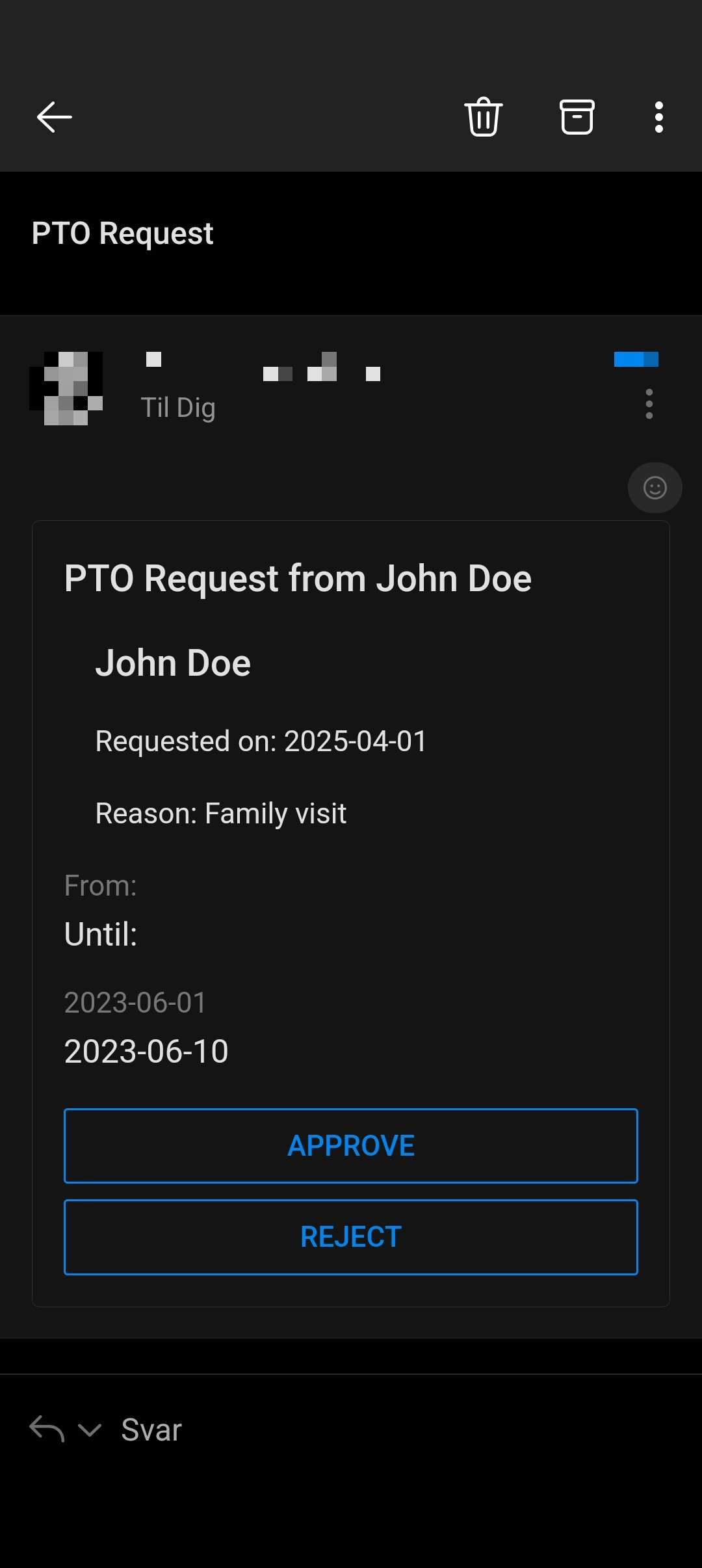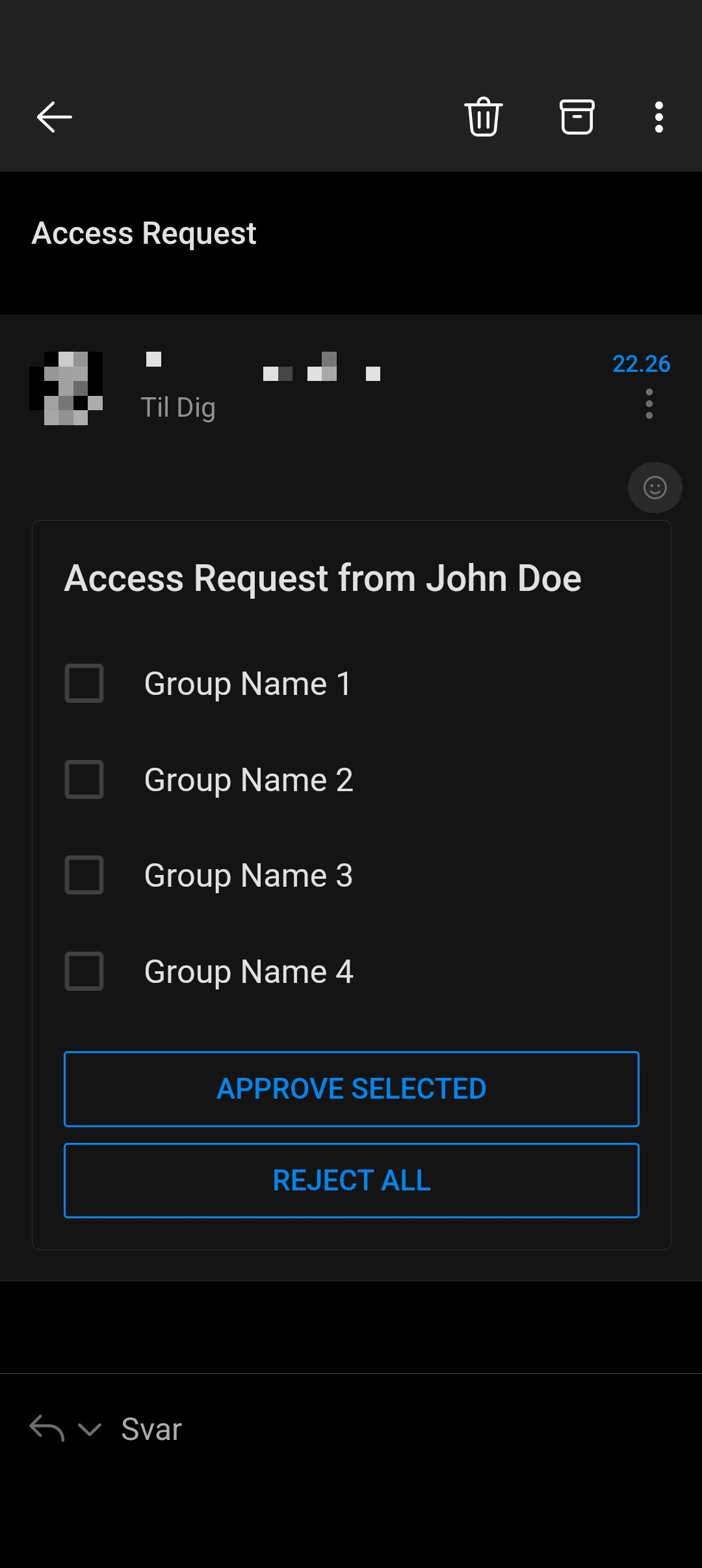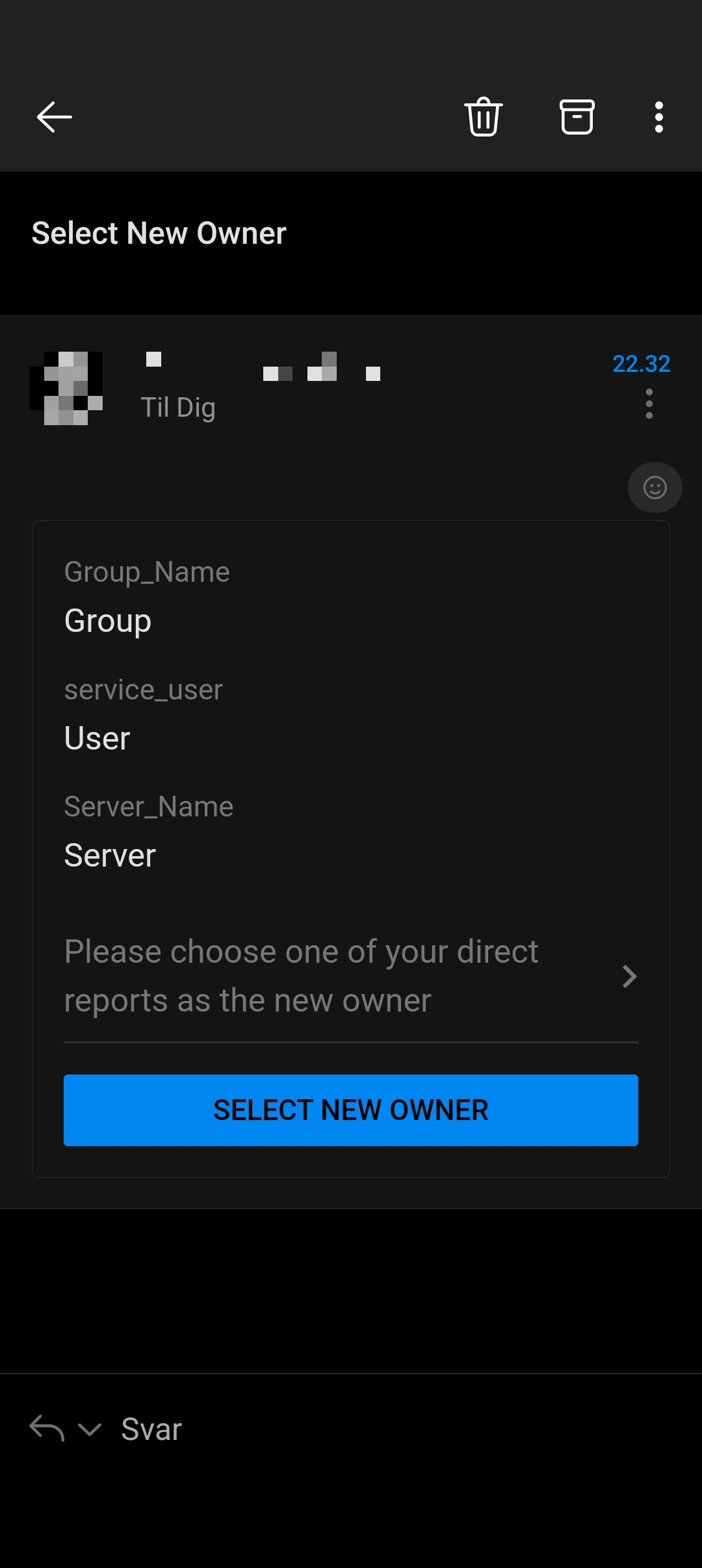ActionableMessages PowerShell Module - Building Interactive Emails Made Easy
Introducing the ActionableMessages PowerShell module - a powerful way to create interactive Adaptive Cards for email
ActionableMessages PowerShell Module
Creating interactive Adaptive Cards for email using Microsoft’s Actionable Messages has never been easier.
In my previous post, we explored the raw JSON approach to creating these cards.
Today, I’m excited to introduce my PowerShell module that simplifies the entire process.
Installing the Module
1
2
# Install from PowerShell Gallery
Install-Module -Name ActionableMessages -Scope CurrentUser
Why Use This Module?
- Simplified Syntax: Create complex cards with intuitive PowerShell commands
- Reduced Errors: No more struggling with nested JSON and escaping special characters
- Improved Readability: Clean PowerShell code instead of complex JSON structures
- Reusable Components: Build and save card components for reuse
Basic Usage
Let’s start with a simple example: OVA result:
Mobile result:
1
2
3
4
5
6
7
8
9
10
11
12
13
14
15
16
17
18
19
20
21
22
23
24
25
26
27
28
29
30
31
32
33
34
35
36
37
38
39
40
41
# Import the module
Import-Module ActionableMessages
# Create a new card
$card = New-AMCard -OriginatorId "1234"
# Add a title
$title = New-AMTextBlock -Text "Hello World" -Size "Large" -Weight "Bolder" -Color "Accent"
Add-AMElement -Card $card -Element $title
# Add a button
$action = New-AMOpenUrlAction -Title "Visit our website" -Url "https://example.com"
$actionSet = New-AMActionSet -Actions @($action)
Add-AMElement -Card $card -Element $actionSet
# Export to HTML for email
$graphParams = Export-AMCardForEmail -Card $card -Subject "Test Card" -ToRecipients "John.Doe@contoso.com" -CreateGraphParams -FallbackText "Your email client doesn't support Adaptive Cards"
Write-Host "Graph parameters created successfully."
$params = $graphParams |ConvertTo-Json -Depth 50
# Default Token Body
$tokenBody = @{
Grant_Type = "client_credentials"
Scope = "https://graph.microsoft.com/.default"
Client_Id = $clientId
Client_Secret = $clientSecret
}
# Request a Token
$tokenResponse = Invoke-RestMethod -Uri "https://login.microsoftonline.com/$tenantId/oauth2/v2.0/token" -Method POST -Body $tokenBody
# Setting up the authorization headers
$authHeaders = @{
"Authorization" = "Bearer $($tokenResponse.access_token)"
"Content-type" = "application/json"
}
# Graph API BASE URI
$graphApiUri = "https://graph.microsoft.com/v1.0"
$uri = "$graphApiUri/users/John.Doe@contoso.com/sendMail"
Invoke-RestMethod -Method POST -Uri $uri -Headers $authHeaders -Body $params
Advanced Examples
Now let’s recreate the examples from my previous post using this module.
PTO Request Card
OVA result:
Mobile result:
1
2
3
4
5
6
7
8
9
10
11
12
13
14
15
16
17
18
19
20
21
22
23
24
25
26
27
28
29
30
31
32
33
34
35
36
37
38
39
40
41
42
43
44
45
46
47
48
49
50
51
52
53
54
55
56
57
58
59
60
61
62
63
64
65
66
67
68
69
70
71
72
73
74
75
# Import the module
Import-Module ActionableMessages
# Create a new card
$card = New-AMCard -OriginatorId "1234"
# Add header
$header = New-AMTextBlock -Text "PTO Request from John Doe" -Size "Medium" -Weight "Bolder"
Add-AMElement -Card $card -Element $header
# Create person info container
$personContainer = New-AMContainer -Id "person-container"
Add-AMElement -Card $card -Element $personContainer
# Create columns for person info
$imageColumn = New-AMColumn -Width "auto" -Items @(
(New-AMImage -Url "https://amdesigner.azurewebsites.net/samples/assets/Miguel_Garcia.png" -Size "Small" -AltText "John Doe")
)
$infoColumn = New-AMColumn -Width "stretch" -Items @(
(New-AMTextBlock -Text "John Doe" -Weight "Bolder"),
(New-AMTextBlock -Text "Requested on: $(Get-Date -Format 'yyyy-MM-dd')" -Size "Small" -IsSubtle $true),
(New-AMTextBlock -Text "Reason: Family visit" -Size "Small" -IsSubtle $true)
)
# Add columns to a column set
$columnSet = New-AMColumnSet -Columns @($imageColumn, $infoColumn) -id "person-columns"
Add-AMElement -Card $card -Element $columnSet -ContainerId "person-container"
# Add date information
$facts = @(
(New-AMFact -Title "From:" -Value "Until:"),
(New-AMFact -Title "2023-06-01" -Value "2023-06-10")
)
$factSet = New-AMFactSet -Facts $facts
Add-AMElement -Card $card -Element $factSet
# Add approve/reject actions
$approveAction = New-AMExecuteAction -Title "Approve" -Verb "POST" `
-Url "https://your-logic-app-url" `
-Body '{"Action":"Approve","user":"john.doe@contoso.com"}'
$rejectAction = New-AMExecuteAction -Title "Reject" -Verb "POST" `
-Url "https://your-logic-app-url" `
-Body '{"Action":"Reject","user":"john.doe@contoso.com"}'
$actionSet = New-AMActionSet -Actions @($approveAction, $rejectAction)
Add-AMElement -Card $card -Element $actionSet
# Or create Microsoft Graph params
$graphParams = Export-AMCardForEmail -Card $card -Subject "PTO Request" `
-ToRecipients "john.doe@contoso.com" -CreateGraphParams
$params = $graphParams |ConvertTo-Json -Depth 50
# Default Token Body
$tokenBody = @{
Grant_Type = "client_credentials"
Scope = "https://graph.microsoft.com/.default"
Client_Id = $clientId
Client_Secret = $clientSecret
}
# Request a Token
$tokenResponse = Invoke-RestMethod -Uri "https://login.microsoftonline.com/$tenantId/oauth2/v2.0/token" -Method POST -Body $tokenBody
# Setting up the authorization headers
$authHeaders = @{
"Authorization" = "Bearer $($tokenResponse.access_token)"
"Content-type" = "application/json"
}
# Graph API BASE URI
$graphApiUri = "https://graph.microsoft.com/v1.0"
$uri = "$graphApiUri/users/john.doe@contoso.com/sendMail"
Invoke-RestMethod -Method POST -Uri $uri -Headers $authHeaders -Body $params
Access Request with Choice Selection
OVA result:
Mobile result:
1
2
3
4
5
6
7
8
9
10
11
12
13
14
15
16
17
18
19
20
21
22
23
24
25
26
27
28
29
30
31
32
33
34
35
36
37
38
39
40
41
42
43
44
45
46
47
48
49
50
51
52
53
54
55
56
57
58
59
60
61
62
63
# Import the module
Import-Module ActionableMessages
# Create a new card
$card = New-AMCard -OriginatorId "1234"
# Add header
$header = New-AMTextBlock -Text "Access Request from John Doe" -Size "Medium" -Weight "Bolder"
Add-AMElement -Card $card -Element $header
# Create choice set for group selection
$choices = @(
(New-AMChoice -Title "Group Name 1" -Value "Group1"),
(New-AMChoice -Title "Group Name 2" -Value "Group2"),
(New-AMChoice -Title "Group Name 3" -Value "Group3"),
(New-AMChoice -Title "Group Name 4" -Value "Group4")
)
$choiceSet = New-AMChoiceSetInput -Id "groupSelection" -Choices $choices `
-Style "expanded" -IsMultiSelect $true -Placeholder "Select groups to approve"
Add-AMElement -Card $card -Element $choiceSet
# Add approve/reject actions
$approveAction = New-AMExecuteAction -Title "Approve Selected" -Verb "POST" `
-Url "https://your-logic-app-url" `
-Body '{"Action":"Approve","Approved_groups":"","user":"john.doe@contoso.com"}'
$rejectAction = New-AMExecuteAction -Title "Reject All" -Verb "POST" `
-Url "https://your-logic-app-url" `
-Body '{"Action":"Reject","Approved_groups":"","user":"john.doe@contoso.com"}'
$actionSet = New-AMActionSet -Actions @($approveAction, $rejectAction)
Add-AMElement -Card $card -Element $actionSet
# Export for email
$emailHtml = Export-AMCardForEmail -Card $card -Subject "Select New Owner" -FallbackText "Please select a new owner"
# Or create Microsoft Graph params
$graphParams = Export-AMCardForEmail -Card $card -Subject "Access Request" `
-ToRecipients "john.doe@contoso.com" -CreateGraphParams
$params = $graphParams |ConvertTo-Json -Depth 50
# Default Token Body
$tokenBody = @{
Grant_Type = "client_credentials"
Scope = "https://graph.microsoft.com/.default"
Client_Id = $clientId
Client_Secret = $clientSecret
}
# Request a Token
$tokenResponse = Invoke-RestMethod -Uri "https://login.microsoftonline.com/$tenantId/oauth2/v2.0/token" -Method POST -Body $tokenBody
# Setting up the authorization headers
$authHeaders = @{
"Authorization" = "Bearer $($tokenResponse.access_token)"
"Content-type" = "application/json"
}
# Graph API BASE URI
$graphApiUri = "https://graph.microsoft.com/v1.0"
$uri = "$graphApiUri/users/john.doe@contoso.com/sendMail"
Invoke-RestMethod -Method POST -Uri $uri -Headers $authHeaders -Body $params
New Owner Selection Card
OVA result:
Mobile result:
Mobile result selection:
1
2
3
4
5
6
7
8
9
10
11
12
13
14
15
16
17
18
19
20
21
22
23
24
25
26
27
28
29
30
31
32
33
34
35
36
37
38
39
40
41
42
43
44
45
46
47
48
49
50
51
52
53
54
55
56
57
58
59
60
61
62
63
64
65
66
67
68
69
70
71
# Create a new card with header and info (similar to previous examples)
$card = New-AMCard -OriginatorId "1234"
# Add facts about resources needing new owner
$facts = @(
(New-AMFact -Title "Group_Name" -Value "Group"),
(New-AMFact -Title "service_user" -Value "User"),
(New-AMFact -Title "Server_Name" -Value "Server")
# More facts as needed
)
$factSet = New-AMFactSet -Facts $facts -Id "facts"
Add-AMElement -Card $card -Element $factSet
# Create choice set for new owner selection
$choices = @(
(New-AMChoice -Title "Bob Bob" -Value "Bob.Bob@contoso.com"),
(New-AMChoice -Title "Jane Doe" -Value "Jane.Doe@contoso.com"),
(New-AMChoice -Title "Shane Doe" -Value "Shane.Doe@contoso.com")
)
$choiceSet = New-AMChoiceSetInput -Id "choice" -Choices $choices `
-Placeholder "Please choose one of your direct reports as the new owner"
Add-AMElement -Card $card -Element $choiceSet
# Transform objects for the payload
$objects = @(
@{ Type = "Group"; Name = "Group_Name" },
@{ Type = "User"; Name = "service_user" },
@{ Type = "Server"; Name = "Server_Name" }
# More objects as needed
)
$objectsJson = $objects | ConvertTo-Json -Compress
# Add action
$selectAction = New-AMExecuteAction -Title "Select new owner" -Verb "POST" `
-Url "https://your-logic-app-url" `
-Body "{`"Action`":`"Approve`",`"New_Owner`":`"`",`"Old_Owner`":`"john.doe@contoso.com`",`"Objects`":$objectsJson}"
$actionSet = New-AMActionSet -Actions @($selectAction)
Add-AMElement -Card $card -Element $actionSet
# Export for email
$emailHtml = Export-AMCardForEmail -Card $card -Subject "Select New Owner" -FallbackText "Please select a new owner"
# Or create Microsoft Graph params
$graphParams = Export-AMCardForEmail -Card $card -Subject "Select New Owner" `
-ToRecipients "john.doe@contoso.com" -CreateGraphParams
$params = $graphParams |ConvertTo-Json -Depth 50
# Default Token Body
$tokenBody = @{
Grant_Type = "client_credentials"
Scope = "https://graph.microsoft.com/.default"
Client_Id = $clientId
Client_Secret = $clientSecret
}
# Request a Token
$tokenResponse = Invoke-RestMethod -Uri "https://login.microsoftonline.com/$tenantId/oauth2/v2.0/token" -Method POST -Body $tokenBody
# Setting up the authorization headers
$authHeaders = @{
"Authorization" = "Bearer $($tokenResponse.access_token)"
"Content-type" = "application/json"
}
# Graph API BASE URI
$graphApiUri = "https://graph.microsoft.com/v1.0"
$uri = "$graphApiUri/users/john.doe@contoso.com/sendMail"
Invoke-RestMethod -Method POST -Uri $uri -Headers $authHeaders -Body $params
Converting Back and Forth
If you already have JSON or want to create it with the Microsoft Actionable Message Designer and want to convert it to PowerShell commands:
1
2
3
# Convert JSON to PowerShell commands
$json = Get-Content -Path "existing-card.json" -Raw
$psCommands = ConvertTo-AMScriptFromJson -Json $json -OutputPath "card-script.ps1"
Benefits Over Raw JSON
- Simplified Development: No need to manually construct complex JSON
- IntelliSense Support: Get command completion and parameter help
- Cleaner Syntax: PowerShell’s pipeline and object model leads to cleaner code
- Reusable Components: Build libraries of card elements
- Easier Debugging: PowerShell error messages are clearer than JSON parsing errors
Conclusion
The ActionableMessages module transforms the complex JSON structure in your scripts for creating Adaptive Cards into a simple, intuitive PowerShell experience.
For more information and source code, check out the GitHub repository.
And also the documentation.
Reference Links








